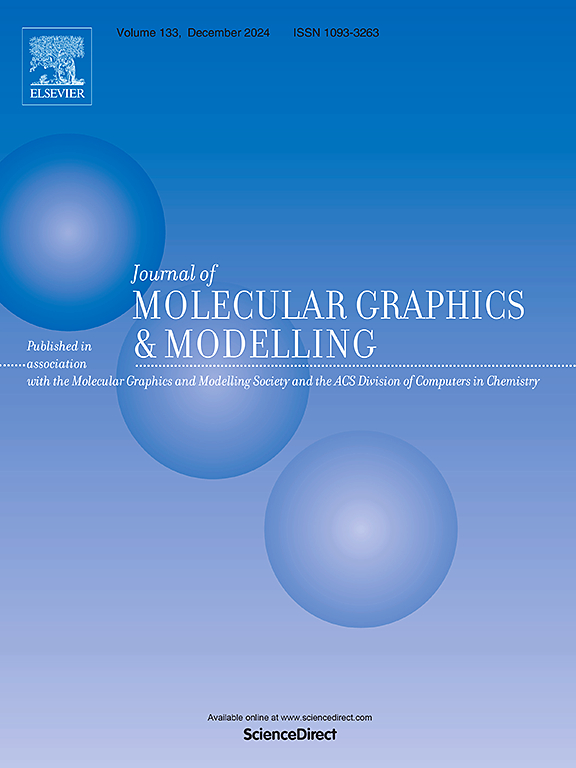光电子器件用层状钙钛矿Rb2AgAsM6 (M = Cl和F)卤化物材料的结构、相稳定性、电子、光学和弹性行为的计算模型
IF 3
4区 生物学
Q2 BIOCHEMICAL RESEARCH METHODS
引用次数: 0
摘要
本文使用DFT模型对Rb2AgAsM6 (M = Cl和F)双钙钛矿卤化物的计算模型进行了全面的研究。Rb2AgAsM6化合物通过满足立方结构的稳定性要求,确保了其未来的应用前景。测定了化合物Rb2AgAsM6 (M = Cl和F)的形成(−817.951,−925.63)eV/原子、内聚(817.951,925.63)eV/原子能和容差因子(0.89,0.78)的结构稳定性和热稳定性。使用GGA-PBE近似。我们发现Rb2AgAsM6 (M = Cl和F)的间接电子带隙在1.34 ~ 2.29 eV之间。这些值表明,由于重阳离子的强自旋轨道耦合,化合物的间接带隙落在可见区内。根据计算的体积模量(41.254,19.851)GPa, Rb2AgAsM6 (M = Cl和F)化合物具有机械Born稳定性。我们发现,当光子能量(eV)作用于Rb2AgAsM6 (M = Cl和F)化合物时,复介电函数促进了最大的电子跃迁和吸收效率。这些结果突出了由Rb2AgAsM6化合物制成的双钙钛矿在能源应用方面的潜力。根据DFT分析,我们的研究证明了Rb2AgAsM6 (M = Cl和F)双钙钛矿的稳定性和优势特性。这些发现强调了Rb2AgAsM6 (M = Cl和F)钙钛矿作为先进太阳能电池、光电器件和下一代技术的环保材料的潜力。本文章由计算机程序翻译,如有差异,请以英文原文为准。

Computational Modelling of the structural, phase stability, electronic, optical, and elastic behaviour of layered perovskites Rb2AgAsM6 (M = Cl and F) halide materials for optoelectronics Devices
The computational modeling of Rb2AgAsM6 (M = Cl and F) double perovskite halides is thoroughly examined in this work using the DFT model. Rb2AgAsM6 compounds ensured their prospective utility by meeting stability requirements for cubic structures. Formation (−817.951, −925.63) eV/atoms, cohesive (817.951, 925.63) eV/atoms energy, and tolerance factor (0.89, 0.78) of the compounds Rb2AgAsM6 (M = Cl and F) are measured for structural and thermal stability. Using the GGA-PBE approx., We found that the indirect electronic band gaps of Rb2AgAsM6 (M = Cl and F) fall between 1.34 eV and 2.29 eV. These values show that because of the strong spin-orbit coupling from heavy cations, the indirect band gaps of compounds fall inside the visible region. The Rb2AgAsM6 (M = Cl and F) compounds have mechanical Born stability, according to the calculated bulk modulus (41.254, 19.851) GPa. We found that when photon energy (eV) is applied to the Rb2AgAsM6 (M = Cl and F) compounds, the complex dielectric function promotes the greatest electron transition and absorption efficiency. These results highlight the potential of double perovskites made of Rb2AgAsM6 compounds for energy applications. According to DFT analysis, our study demonstrates the stability and advantageous characteristics of Rb2AgAsM6 (M = Cl and F) double perovskites. These findings underscore the potential of Rb2AgAsM6 (M = Cl and F) perovskites as environmentally friendly materials for advanced solar cells, optoelectronic devices, and next-generation technologies.
求助全文
通过发布文献求助,成功后即可免费获取论文全文。
去求助
来源期刊

Journal of molecular graphics & modelling
生物-计算机:跨学科应用
CiteScore
5.50
自引率
6.90%
发文量
216
审稿时长
35 days
期刊介绍:
The Journal of Molecular Graphics and Modelling is devoted to the publication of papers on the uses of computers in theoretical investigations of molecular structure, function, interaction, and design. The scope of the journal includes all aspects of molecular modeling and computational chemistry, including, for instance, the study of molecular shape and properties, molecular simulations, protein and polymer engineering, drug design, materials design, structure-activity and structure-property relationships, database mining, and compound library design.
As a primary research journal, JMGM seeks to bring new knowledge to the attention of our readers. As such, submissions to the journal need to not only report results, but must draw conclusions and explore implications of the work presented. Authors are strongly encouraged to bear this in mind when preparing manuscripts. Routine applications of standard modelling approaches, providing only very limited new scientific insight, will not meet our criteria for publication. Reproducibility of reported calculations is an important issue. Wherever possible, we urge authors to enhance their papers with Supplementary Data, for example, in QSAR studies machine-readable versions of molecular datasets or in the development of new force-field parameters versions of the topology and force field parameter files. Routine applications of existing methods that do not lead to genuinely new insight will not be considered.
 求助内容:
求助内容: 应助结果提醒方式:
应助结果提醒方式:


